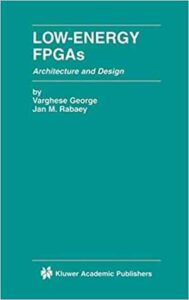نام کتاب: Low-Energy Fpgas — Architecture And Design
نویسنده: Varghese George و Jan M. Rabaey
ویرایش: ۱
سال انتشار: ۲۰۰۱
کد ISBN کتاب: ۹۷۸۱۴۶۱۳۵۵۴۵۸, ۹۷۸۱۴۶۱۵۱۴۲۱۳,
فرمت: PDF
تعداد صفحه: ۱۸۲
حجم کتاب: ۱۴ مگابایت
کیفیت کتاب: OCR
انتشارات: Springer Us
Description About Book Low-Energy Fpgas — Architecture And Design From Amazon
Low-Energy FPGAs: Architecture and Design is a primary resource for both researchers and practicing engineers in the field of digital circuit design.
The book addresses the energy consumption of Field-Programmable Gate Arrays (FPGAs). FPGAs are becoming popular as embedded components in computing platforms. The programmability of the FPGA can be used to customize implementations of functions on an application basis. This leads to performance gains, and enables reuse of expensive silicon.
Chapter 1 provides an overview of digital circuit design and FPGAs. Chapter 2 looks at the implication of deep-submicron technology onFPGA power dissipation. Chapter 3 describes the exploration environment to guide and evaluate design decisions. Chapter 4 discusses the architectural optimization process to evaluate the trade-offs between the flexibility of the architecture, and the effect on the performance metrics. Chapter 5 reviews different circuit techniques to reduce the performance overhead of some of the dominant components. Chapter 6 shows methods to configure FPGAs to minimize the programming overhead. Chapter 7 addresses the physical realization of some of the critical components and the final implementation of a specific low-energy FPGA. Chapter 8 compares the prototype array to an equivalent commercial architecture.
درباره کتاب Low-Energy Fpgas — Architecture And Design ترجمه شده از گوگل
FPGA های کم مصرف: معماری و طراحی منبع اصلی هم برای محققان و هم برای مهندسان متبحر در زمینه طراحی مدار دیجیتال است.
این کتاب به مصرف انرژی آرایه های دروازه قابل برنامه ریزی (FPGA) می پردازد. FPGA به عنوان اجزای تعبیه شده در سیستم عامل های رایانه محبوب می شوند. از برنامه پذیری FPGA می توان برای شخصی سازی پیاده سازی توابع بر اساس برنامه استفاده کرد. این منجر به افزایش عملکرد می شود و امکان استفاده مجدد از سیلیکون گران را فراهم می کند.
در فصل ۱ مروری بر طراحی مدار دیجیتال و FPGA وجود دارد. در فصل ۲ تأثیرات فناوری عمیق زیر میکرون در اتلاف انرژی FPGA بررسی می شود. فصل ۳ محیط اکتشاف را برای راهنمایی و ارزیابی تصمیمات طراحی توصیف می کند. در فصل ۴ روند بهینه سازی معماری برای ارزیابی معاملات بین انعطاف پذیری معماری و تأثیر بر معیارهای عملکرد بحث شده است. فصل ۵ تکنیک های مختلف مدار را برای کاهش عملکرد سربار برخی از اجزای غالب مرور می کند. فصل ۶ روشهای پیکربندی FPGA را برای به حداقل رساندن سربار برنامه نویسی نشان می دهد. فصل ۷ تحقق فیزیکی برخی از اجزای حیاتی و اجرای نهایی یک FPGA کم انرژی خاص را بیان می کند. در فصل ۸ نمونه اولیه آرایه با معماری معادل تجاری مقایسه می شود.
[box type=”info”]![]() جهت دسترسی به توضیحات این کتاب در Amazon اینجا کلیک کنید.
جهت دسترسی به توضیحات این کتاب در Amazon اینجا کلیک کنید.![]() در صورت خراب بودن لینک کتاب، در قسمت نظرات همین مطلب گزارش دهید.
در صورت خراب بودن لینک کتاب، در قسمت نظرات همین مطلب گزارش دهید.

